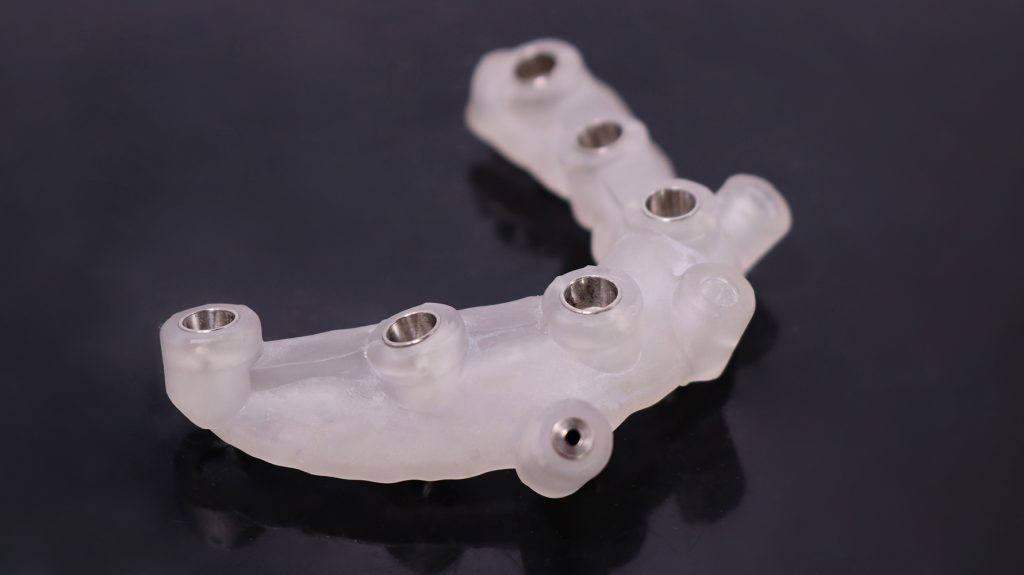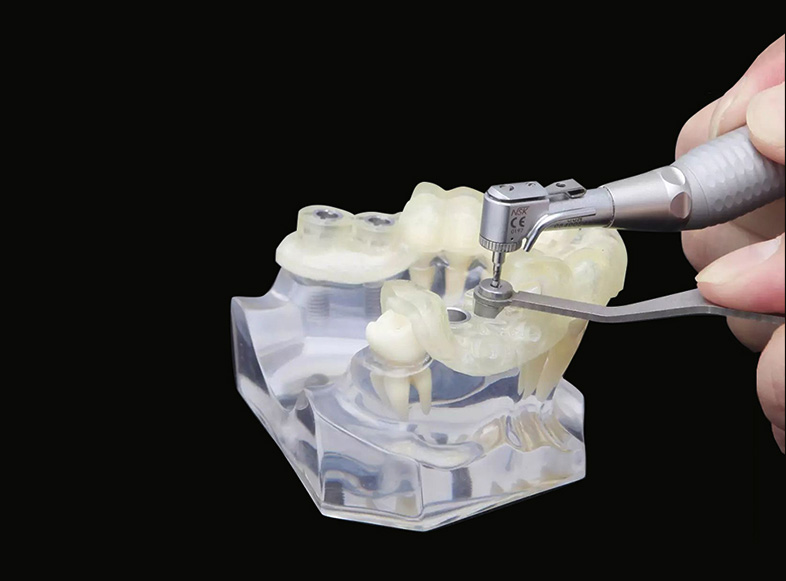“I find surgical guides absolutely necessary. We perform all surgeries with drilling templates as standard in our practice. This is not optional for us.”
Dr. Sebastian Horvath, Dentist, Specialist for Prosthodontics (DGPro)

What is a Surgical Guide?
Dental surgical guides help dentists place dental implants properly and in the right locations. In order to create a surgical guide, impressions are taken at the desired surgical impact site, including 3D images. These impressions and imaging are then transferred to special software that develops the guides. They are then printed using a resin 3D printer and surgical guide resin. These clear guides are then placed over the patient’s teeth and the dentist can easily find the area where the implant should be placed.
Three techniques to make dental surgical guides
1. Traditional implanting guides
The traditional planting guide is a simple guide made by pressing the film sheet with a vacuum forming machine. The guide plate has low cost, simple manufacture, and guides the position and direction of the implant restoration, and is mostly used for patients with better bone quality. There are certain limitations in the case of multiple missing teeth and insufficient alveolar bone mass, and the accuracy of implant placement is poor, and it may even lead to implant failure.
2. Digital implanting guides
The digital implantation guide is based on CT data, designed by professional implantation software, combined with rapid prototyping and other technologies. This kind of guide plate can well control the direction, angle and depth of implant placement. However, there are multiple steps in the manufacturing process, each of which may cause errors, and requires other software and equipment to be used in conjunction with high costs. It is affected by the patient’s opening, which reduces the control over the implant site and direction.
3. Improved implanting guides
The modified guide uses the patient’s existing dentures or restores the upper prosthesis first, combines imaging markers and CT images to design the implant placement position, and converts it to the model to make the guide. This guide is equipped with a surgical handpiece guide with a handpiece extension that matches the guide. The improved implant guide plate removes the drill bit for multi-level guided surgery, avoids frequent replacement of the guide sleeve, and simplifies the operation steps to a certain extent, so that the operating area is fully exposed and the cooling water can smoothly enter the operating area.
Different ways to classify dental implant surgical guides
1. According to the different support methods
they are divided into mucosa-supported, tooth-supported, mixed-supported, and bone-supported:
- Tooth-supported guide: The guide is fixed on the adjacent teeth in the missing area, and is suitable for single tooth defects. Or dentition defect with a small number of missing teeth;
- mucosa-supported guide plate: the guide plate is directly fixed on the mucosa of the edentulous area, suitable for dentition defects or missing dentition with multiple consecutive missing teeth;
- mixed Supported guide plate: It is supported by the remaining natural teeth and mucosal tissue, and is mostly used for patients with many missing teeth, especially when the free ends are missing;
- Bone-supported guide plate: The operation requires flaps, and the guide plate is directly fixed on the The bone surface of the edentulous area is suitable for patients with dentition defects or missing dentitions with a large number of missing teeth.
2. According to the degree of guidance
They can be divided into unrestricted guides, partial restricted guides, and full restricted guides.
The non-restricted guide, also known as the site-restricted guide, only provides the ideal site for implant placement in the implant area, and does not control the direction, angle and depth of implantation. Partially restricting the guide plate, only controls the first drill of implant placement, which limits the implantation site and direction, and the operator controls the guide plate by free hand for the subsequent step-by-step hole preparation. limit. The full limit guide, also known as the full limit guide, controls the position, direction, depth and angle of implant placement throughout the process.
3. According to the use of the guide
They can be divided into radiation guide, surgical guide, and repair guide.
The patient wears a radiation guide to take CT, and the soft tissue information in the patient’s mouth can be obtained, and the fusion of CT data can obtain accurate information of the patient’s soft and hard tissue. The surgical guide plate integrates the collected patient information and designs a surgical plan including implantation site, direction, and depth, and transfers this information to a carrier for use in implantation surgery. Restorative guide plate, guided by the restoration, combined with the occlusal relationship of the adjacent teeth and the opposite teeth to guide the restoration of the missing tooth area.


